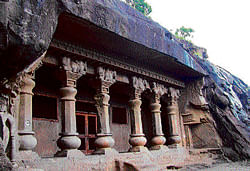
Not far from the city of Nasik in Maharashtra, is a fair-sized green hill called Trirashmi. As you approach the hill, you can see a dark grey gash marring the face of the hill.
Climb a few hundred easily-mountable stone steps up the hill, and the gash turns out to be the breathtaking 2,000-year-old caves known as Pandavleni. These caves have been carved out of the face of the rock.
The carving of the caves was carried out between 1st century BC to 2nd century AD, and is a prime example of the rock-cut architecture of that age. From what is known of the history of the caves, it is believed to have been started by Jains, and completed by monks of the Buddhist Hinayana sect.
At one point, it was a fairly important centre for Buddhist learning. The name, Pandavleni, however, comes from the legend that the Pandavas hid here in the caves for a while, during their exile. So, as is so often the case in India, this spot has a number of faiths associated with it!
The caves have inscriptions of historical significance from the era of the Satavahana Dynasty, which prospered after the decline of the Maurya Dynasty. History aside, what attracts the layperson is the magnificent facade of these caves, dignified and beautiful. There are 24 caves in all.
The interiors of the caves are very plain, but the exteriors are elaborately carved. Beautiful, pillared entrances and exquisitely carved doorways are the highlights of these caves.
Most of the caves are viharas, dwelling places of Buddhist monks, while about three are chaityas or prayer halls. Some caves are connected to others by stone-cut stairs — which are steep, yet easy to climb. This place also apparently had a good water system — there are a number of water reservoirs cut from stone, which now hold rain water.
The smaller viharas are very interesting. They are small rooms, with little niches for sleeping, perhaps. Some of the caves have small doorways, compelling you to bend low to enter, while some don’t have doorways at all. Little stone-cut steps lead from one vihara to another. The larger viharas are awe-inspiring. They are huge, imposing halls, and contain as many as 18 cells within them.
The largest chaitya is remarkable. It is quite large, with imposing pillars. One can very well imagine the chorus of prayers and the sonorous drone of sermons that probably echoed and ricocheted off the walls, drowning the monks in sound!
Since the caves face north-east, they are best visited at dawn, when the soft rays of the morning sun gradually illuminate the gorgeous carvings. These caves have an aura of timelessness, and as I descended, I took away some of that with me.